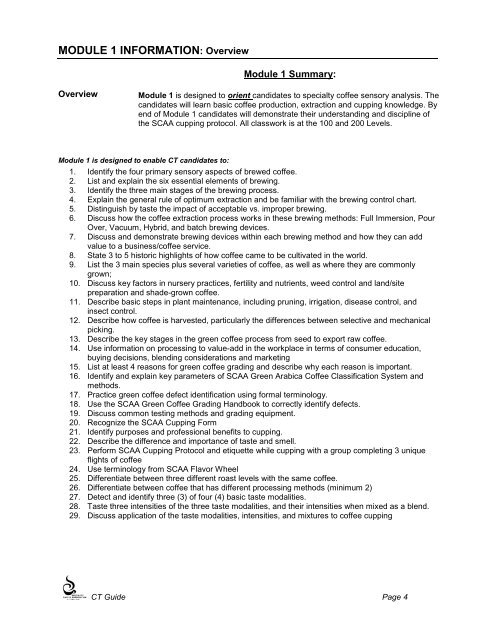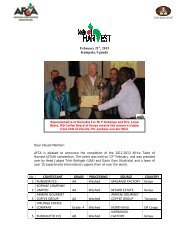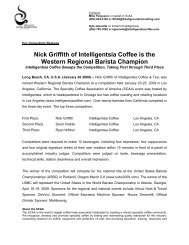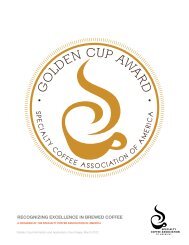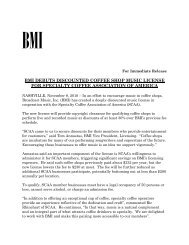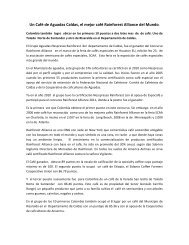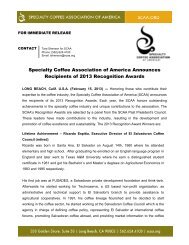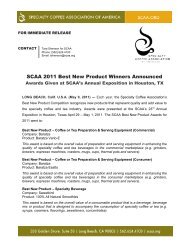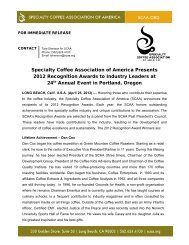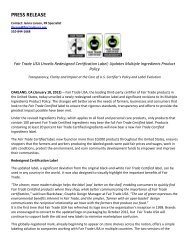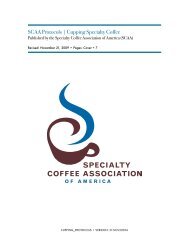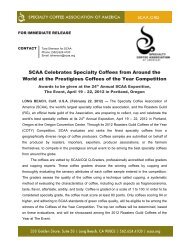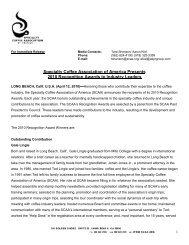Coffee Taster Certificate Program Handbook - SCAA
Coffee Taster Certificate Program Handbook - SCAA
Coffee Taster Certificate Program Handbook - SCAA
Create successful ePaper yourself
Turn your PDF publications into a flip-book with our unique Google optimized e-Paper software.
MODULE 1 INFORMATION: Overview<br />
Module 1 Summary:<br />
Overview<br />
Module 1 is designed to orient candidates to specialty coffee sensory analysis. The<br />
candidates will learn basic coffee production, extraction and cupping knowledge. By<br />
end of Module 1 candidates will demonstrate their understanding and discipline of<br />
the <strong>SCAA</strong> cupping protocol. All classwork is at the 100 and 200 Levels.<br />
Module 1 is designed to enable CT candidates to:<br />
1. Identify the four primary sensory aspects of brewed coffee.<br />
2. List and explain the six essential elements of brewing.<br />
3. Identify the three main stages of the brewing process.<br />
4. Explain the general rule of optimum extraction and be familiar with the brewing control chart.<br />
5. Distinguish by taste the impact of acceptable vs. improper brewing.<br />
6. Discuss how the coffee extraction process works in these brewing methods: Full Immersion, Pour<br />
Over, Vacuum, Hybrid, and batch brewing devices.<br />
7. Discuss and demonstrate brewing devices within each brewing method and how they can add<br />
value to a business/coffee service.<br />
8. State 3 to 5 historic highlights of how coffee came to be cultivated in the world.<br />
9. List the 3 main species plus several varieties of coffee, as well as where they are commonly<br />
grown;<br />
10. Discuss key factors in nursery practices, fertility and nutrients, weed control and land/site<br />
preparation and shade-grown coffee.<br />
11. Describe basic steps in plant maintenance, including pruning, irrigation, disease control, and<br />
insect control.<br />
12. Describe how coffee is harvested, particularly the differences between selective and mechanical<br />
picking.<br />
13. Describe the key stages in the green coffee process from seed to export raw coffee.<br />
14. Use information on processing to value-add in the workplace in terms of consumer education,<br />
buying decisions, blending considerations and marketing<br />
15. List at least 4 reasons for green coffee grading and describe why each reason is important.<br />
16. Identify and explain key parameters of <strong>SCAA</strong> Green Arabica <strong>Coffee</strong> Classification System and<br />
methods.<br />
17. Practice green coffee defect identification using formal terminology.<br />
18. Use the <strong>SCAA</strong> Green <strong>Coffee</strong> Grading <strong>Handbook</strong> to correctly identify defects.<br />
19. Discuss common testing methods and grading equipment.<br />
20. Recognize the <strong>SCAA</strong> Cupping Form<br />
21. Identify purposes and professional benefits to cupping.<br />
22. Describe the difference and importance of taste and smell.<br />
23. Perform <strong>SCAA</strong> Cupping Protocol and etiquette while cupping with a group completing 3 unique<br />
flights of coffee<br />
24. Use terminology from <strong>SCAA</strong> Flavor Wheel<br />
25. Differentiate between three different roast levels with the same coffee.<br />
26. Differentiate between coffee that has different processing methods (minimum 2)<br />
27. Detect and identify three (3) of four (4) basic taste modalities.<br />
28. Taste three intensities of the three taste modalities, and their intensities when mixed as a blend.<br />
29. Discuss application of the taste modalities, intensities, and mixtures to coffee cupping<br />
CT Guide Page 4


